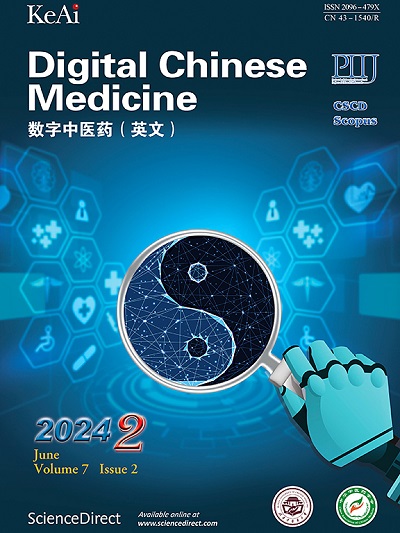急性缺血性脑卒中气虚血瘀证临床特征分析及诊断预测
Q3 Medicine
引用次数: 0
摘要
目的探讨急性缺血性脑卒中(AIS)患者气虚血瘀证的临床特点及辨证预测方法,建立气虚血瘀证预测模型。方法采用回顾性病例对照设计,对2013年1月1日至2022年12月31日在湖南中医药大学第一医院神经内科住院的AIS患者进行分析。符合气虚血瘀证诊断标准的AIS患者分为病例组,不符合气虚血瘀证诊断标准的AIS患者分为对照组。收集两组患者的人口学特征(年龄、性别)、临床参数(发病至入院时间、美国国立卫生研究院卒中量表(NIHSS)评分、血压)、既往病史、中医诊断特征(舌脉)、神经系统症状和体征、影像学表现(磁共振成像-弥散加权成像(MRI-DWI))、生化指标进行比较。有统计学差异的指标(P <;采用多因素logistic回归分析,评价其对气虚血瘀证诊断的预测价值,并采用受试者工作特征(ROC)曲线分析构建预测模型。结果纳入AIS患者1 035例,病例组404例,对照组631例。与对照组相比,病例组患者年龄明显增大,发病至入院时间延长,舒张压降低,NIHSS评分降低(P <;0.05)。病例组高血压病史发生率较低(P <;0.05)。舌脉特征方面,病例组以舌色淡暗、舌苔白、脉细、脉涩、脉沉多见。影像学检查显示病例组半瓣膜体梗死、脑萎缩和椎动脉狭窄的比例较高(P <;0.05)。在生化指标中,病例组空腹血糖和糖化血红蛋白(HbA1c)升高的比例较高,白细胞计数升高、血红蛋白降低、高密度脂蛋白胆固醇(HDL-C)降低的比例较低(P <;0.05)。多因素logistic回归分析发现气虚血瘀证的显著预测因素包括:细脉[比值比(OR) = 4.38]、脉窄(OR = 3.67)、浅表感觉异常(OR = 1.86)、半瓣膜中心梗死(OR = 1.57)、脑萎缩(OR = 1.55)、椎动脉狭窄(OR = 1.62)、HbA1c升高(OR = 3.52)。综合预测模型的ROC曲线分析得出曲线下面积(AUC)为0.878[95%置信区间(CI) = 0.855 ~ 0.900]。结论气虚血瘀证是AIS的主要证型之一。脉细、脉涩、浅表感觉异常、半瓣膜梗死、脑萎缩、椎动脉狭窄、血糖升高、糖化血红蛋白升高、舌色苍白暗、舌苔白是AIS气虚血瘀证辨证的客观诊断重点指标。基于这些指标,建立辨证预测模型,为临床诊断提供更客观的依据,有助于在临床实践中快速识别该证候,减少误诊和漏诊。本文章由计算机程序翻译,如有差异,请以英文原文为准。
Analysis of clinical characteristics and diagnostic prediction of Qi deficiency and blood stasis syndrome in acute ischemic stroke
Objective
To explore the clinical characteristics and methods for syndrome differentiation prediction, as well as to construct a predictive model for Qi deficiency and blood stasis syndrome in patients with acute ischemic stroke (AIS).
Methods
This study employed a retrospective case-control design to analyze patients with AIS who received inpatient treatment at the Neurology Department of The First Hospital of Hunan University of Chinese Medicine from January 1, 2013 to December 31, 2022. AIS patients meeting the diagnostic criteria for Qi deficiency and blood stasis syndrome were stratified into case group, while those without Qi deficiency and blood stasis syndrome were stratified into control group. The demographic characteristics (age and gender), clinical parameters [time from onset to admission, National Institutes of Health Stroke Scale (NIHSS) score, and blood pressure], past medical history, traditional Chinese medicine (TCM) diagnostic characteristics (tongue and pulse), neurological symptoms and signs, imaging findings [magnetic resonance imaging-diffusion weighted imaging (MRI-DWI)], and biochemical indicators of the two groups were collected and compared. The indicators with statistical difference (P < 0.05) in univariate analysis were included in multivariate logistic regression analysis to evaluate their predictive value for the diagnosis of Qi deficiency and blood stasis syndrome, and the predictive model was constructed by receiver operating characteristic (ROC) curve analysis.
Results
The study included 1 035 AIS patients, with 404 cases in case group and 631 cases in control group. Compared with control group, patients in case group were significantly older, had extended onset-to-admission time, lower diastolic blood pressure, and lower NIHSS scores (P < 0.05). Case group showed lower incidence of hypertension history (P < 0.05). Regarding tongue and pulse characteristics, pale and dark tongue colors, white tongue coating, fine pulse, astringent pulse, and sinking pulse were more common in case group. Imaging examinations demonstrated higher proportions of centrum semiovale infarction, cerebral atrophy, and vertebral artery stenosis in case group (P < 0.05). Among biochemical indicators, case group showed higher proportions of elevated fasting blood glucose and glycated hemoglobin (HbA1c), while lower proportions of elevated white blood cell count, reduced hemoglobin, and reduced high-density lipoprotein cholesterol (HDL-C) (P < 0.05). Multivariate logistic regression analysis identified significant predictors for Qi deficiency and blood stasis syndrome including: fine pulse [odds ratio (OR) = 4.38], astringent pulse (OR = 3.67), superficial sensory abnormalities (OR = 1.86), centrum semiovale infarction (OR = 1.57), cerebral atrophy (OR = 1.55), vertebral artery stenosis (OR = 1.62), and elevated HbA1c (OR = 3.52). The ROC curve analysis of the comprehensive prediction model yielded an area under the curve (AUC) of 0.878 [95% confidence interval (CI) = 0.855 – 0.900].
Conclusion
This study finds out that Qi deficiency and blood stasis syndrome represents one of the primary types of AIS. Fine pulse, astringent pulse, superficial sensory abnormalities, centrum semiovale infarction, cerebral atrophy, vertebral artery stenosis, elevated blood glucose, elevated HbA1c, pale and dark tongue colors, and white tongue coating are key objective diagnostic indicators for the syndrome differentiation of AIS with Qi deficiency and blood stasis syndrome. Based on these indicators, a syndrome differentiation prediction model has been developed, offering a more objective basis for clinical diagnosis, and help to rapidly identify this syndrome in clinical practice and reduce misdiagnosis and missed diagnosis.
求助全文
通过发布文献求助,成功后即可免费获取论文全文。
去求助
来源期刊

Digital Chinese Medicine
Medicine-Complementary and Alternative Medicine
CiteScore
1.80
自引率
0.00%
发文量
126
审稿时长
63 days
期刊介绍:
 求助内容:
求助内容: 应助结果提醒方式:
应助结果提醒方式:


